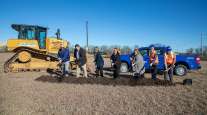Staff Reporter
Real-Time Alerts Coming to Kansas Rural Freight Corridor

[Stay on top of transportation news: Get TTNews in your inbox.]
Truckers driving through the U.S. Route 83 rural freight corridor in Kansas will benefit from a $6.67 million federal grant to help fund a long fiber optic network to deliver real-time traffic, weather and other useful information in that remote agricultural stretch.
U.S. 83 is a major two-lane freight route, particularly for agriculture products, that sees some 5,000 commercial trucks daily.
More than 40% of the state’s international agricultural exports are produced around U.S. 83. Generating $21 billion in cash directly from agricultural projects, Kansas ranks sixth largest in the nation for its agricultural economy after Illinois. (The top state is California’s $51 billion, followed by Iowa, Nebraska and Texas.)
“Traffic averages 2,500 to 5,000 vehicles per day in the corridor’s middle to more than 10,000 per day at either end where agricultural product manufacturers and distributors are most concentrated,” said Steve Hale, spokesman at Kansas Department of Transportation.
AT&T has the only fiber optic network along U.S. 83 and “is really not being used by others along the route at this time,” Hale said.
KDOT is starting internal planning for the work and will be retaining a consultant. Hale said the project planning, designing and construction will be completed within two years once an agreement date is set for the project.
Kansas state officials met Sept. 7 at McCarty Family Farms, home to some 17,000 registered Holstein dairy cattle, next to Route 83 to laud the capture of the Federal Highway Administration grant awarded Aug. 6.
.@SecJulieLorenz said, “To deliver for Kansas, transportation and ag need to be good partners. This is a great project that improves freight flow, safety and could get broadband to rural areas more cost
effectively." pic.twitter.com/x2jjfn3wTV — Kansas Department of Transportation (@KDOTHQ) September 7, 2022
The grant, from the Advanced Transportation and Congestion Management Technologies Deployment program, will help pay for the $14.6 million project called the Great Plains Rural Freight Technology Corridor.
Julie Lorenz, Kansas Secretary of Transportation, joined Mike Beam, state agriculture secretary, and Ken McCarty, who co-owns the McCarty Family Farms dairy business with other family members. “This is a great project that improves freight flow, safety and could get broadband to rural areas more cost effectively,” Lorenz said.
The heart of the state’s agriculture industry includes five counties, anchored for more than 130 miles by U.S. 83, a north-south critical rural freight corridor in western Kansas. The counties — Thomas, Logan, Gove, Scott and Finney — are major players in the Kansas livestock, grain, gas and biofuels industries.
With dairy operations in Scott City and Rexford both directly in the heart of the U.S. 83 corridor, McCarty Farms wrote a letter supporting the grant.

Activity on U.S. 83 north of Scott City. (Kansas Department of Transportation)
“McCarty’s dairy operation involves hundreds of trucks entering and exiting the facilities on a daily basis and slipping into the mix of other haulers using this busy freight route,” Hale said.
KDOT’s plan is to incorporate technology (including sensors and cameras) to provide real-time information to drivers such as weather conditions and traffic crashes. Truckers will be able to access information via hands-free devices. Also, KDOT’s KanDrive.org website will also have this information for viewing and use by truck dispatch centers to relay conditions to drivers. The system will upgrade communications for emergency responders.
According to KDOT, these advanced corridor communications are vital to time-sensitive deliveries of livestock and produce.
“Enhanced connectivity in our highly productive but remote areas of the state is a continued challenge voiced by agriculture leaders in multiple sectors of our ag economy,” Beam said. “This cutting-edge service will make a significant impact to this important corridor in Kansas.”
The new technology will improve safety along U.S. 83, located on high plains and susceptible to high winds, blowing dust and storms. Trucks and farm equipment account for up to one-third of total traffic there. In rural areas like the U.S. 83 corridor, significant travel delays can be caused by traffic, weather and accidents along the long stretch of roadway since finding an alternative route is impossible without significant advance notice.
“The project will result in safer, more efficient commercial truck traffic on U.S. 83 by better managing corridor truck movements. It will improve routing choices forced by corridor traffic incidents or weather conditions, reduce queuing and minimize impacts on commercial drivers trying to balance real-world traffic conditions with the demands of just-in-time manufacturing and pick-up/drop-off scheduling,” according to KDOT.
Also a supply line for oil and gas, U.S. 83 is a landlocked anchor point in Kansas for international supply chain products bound for 89 different countries, including its top markets in Canada, Mexico, Japan, South Korea and China.
“Getting broadband to rural areas more cost effectively by leveraging the state’s right of way is smart,” Lorenz said. “This will expand access to broadband and open more opportunities for Kansans to utilize technology in their homes and businesses.”
Want more news? Listen to today's daily briefing below or go here for more info:




